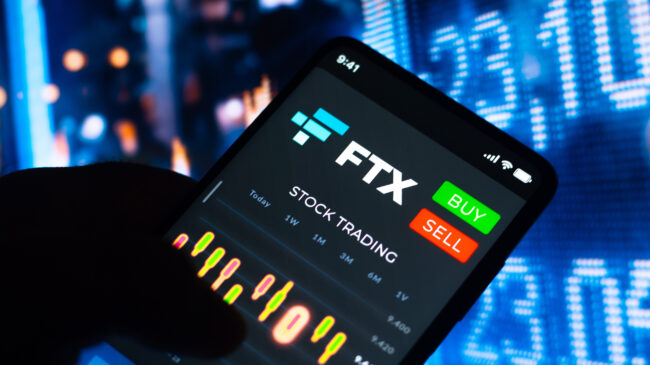With the recent bankruptcy of FTX, one the largest cryptocurrency exchange platforms, new questions arise regarding how much exposure public pension funds have, or should have, to FTX or cryptocurrencies in general. The crypto market is down 70-90% from last year (depending on the coin), and the stock market is down 15% from last year, in comparison. The market downturn, along with the general volatility in investment returns over the past couple of years, is a vivid reminder that public pension systems need to take a responsible, cautious approach to investing and should not take risks chasing higher yields.
Public pension plans have mostly avoided direct investments into cryptocurrencies, and for good reason. Public pension benefits are constitutionally protected, meaning taxpayers are on the hook for paying for unfunded liabilities. If a highly volatile investment, such as crypto, were to go sour, the public pension fund—thus, taxpayers—would be on the hook to make up for the shortfall and pay for the retirement benefits promised to public workers. Even though there is a potential upside in generating significant returns by investing in cryptocurrency at the right times, the risks and market swings far outweigh the potential benefits for public pension systems.
But some U.S. public pension systems are already reporting minor financial losses related to FTX, including the Kansas Public Employee Retirement System, according to the Topeka Capital-Journal:
Kansas’ pension fund reported a small investment in the ill-fated cryptocurrency company FTX, a spokesperson for the Kansas Public Employee Retirement System said Monday. The fund’s exposure, or investment, in FTX and its affiliated companies was $187,400, Kristen Basso, a KPERS spokesperson, said in an email. That accounts for 0.0008% of the pension fund’s total holdings as of the end of the 2022 fiscal year in July.
Similarly, “The Missouri State Employees’ Retirement System lost roughly $1 million because a private equity firm it invested in was invested in FTX, the embattled cryptocurrency exchange that filed for bankruptcy last week,” the Kansas City Star reported.
While these are small losses, and there seems to be limited exposure for public pensions directly investing in FTX, there are larger concerns about indirect exposure to cryptocurrencies like those described for Missouri. For example, Sequoia Capital was one of the largest investors in FTX, with its potential losses totaling over $200 million. Tiger Global was another large investor in FTX, with losses totaling around $38 million. Both funds had recently partnered with the largest public pension plan in the nation, the California Public Employees Retirement System (CalPERS), which committed roughly $300 million each to Sequoia Capital and Tiger Global in search of higher yields.
Pensions & Investments reported on other public pension plans in similar situations:
The Alaska Permanent Fund Corp., the Washington State Investment Board and other institutions were indirect investors [in FTX] via Sequoia Capital and other venture capital firms. Among investors in Institutional Venture Partners fund with exposure to FTX are Tennessee Consolidated Retirement System; City & County of San Francisco Employees’ Retirement System; Maryland State Retirement & Pension System; and Alaska Permanent Fund Corp. Illinois Municipal Retirement Fund was invested in Lightspeed Venture Partners, which also had exposure to FTX.
These examples highlight that while there might not be a lot of direct investments in FTX or cryptocurrencies by public pension funds, their indirect exposure may also need to be closely monitored and evaluated.
One public pension plan with a fair amount of crypto-related risk is the Fairfax County Police Officers Retirement System. MarketWatch reported:
The Fairfax County Police Officers Retirement System, a defined-benefit pension plan covering law-enforcement officers in the sprawling northern Virginia county, has over 7% of assets invested in crypto-related holdings, according to a person familiar with the fund, spread across venture capital and hedge fund holdings as well as “yield farming” through funds that provide short-term loans to crypto-related firms.
Many public pension plans are unfortunately stuck in a precarious situation where, due to their lofty investment return assumptions, they are searching for unrealistically high returns in an increasingly challenging market environment. This has led some pension plans to look at instruments like crypto, as well as non-fungible tokens (NFTs) and special purpose acquisition companies (SPACs) to keep up with overly optimistic investment return assumptions and their plan’s funding requirements.
Overall, the story of FTX is a cautionary tale for all investors. When it comes to public pension systems, which have largely steered clear of making direct investments in crypto, pension funds should resist the growing pressures to seek higher returns and take on risks that could expose taxpayers to major financial losses and more public pension debt.
Stay in Touch with Our Pension Experts
Reason Foundation’s Pension Integrity Project has helped policymakers in states like Arizona, Colorado, Michigan, and Montana implement substantive pension reforms. Our monthly newsletter highlights the latest actuarial analysis and policy insights from our team.

